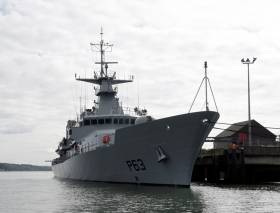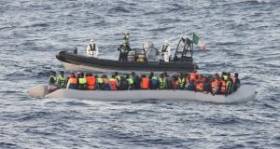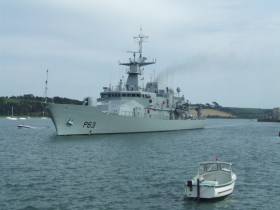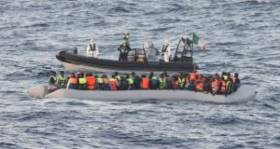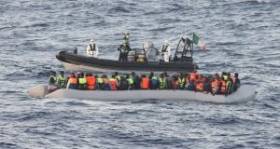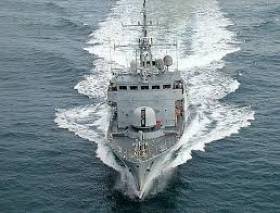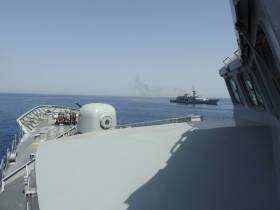Displaying items by tag: Navy
Medal for LE James Joyce On Humanitarian Missions
#CrewMedal - The Defence Forces writes The Irish Independent, have awarded a new military medal to members who have been deployed on humanitarian missions.
It will be presented to personnel who have taken part in overseas missions with the prior approval of the Government.
Up to now, the military have been awarded medals by either the United Nations, the EU or Nato for most missions outside of the State.
But those deployed on humanitarian missions, such as the current Operation Pontus, where the Naval Service have been rescuing migrants from the Mediterranean since last year, have not been similarly recognised.
The decision to award the new medal was announced yesterday by Minister with responsibility for Defence, Paul Kehoe, when he visited the captain and crew of LE James Joyce in Cagliari in Sardinia. The presentation of the medals will take place in Rosslare, Co Wexford, next month.
LE James Joyce is the fifth Naval vessel to have been deployed since the Irish joined the Mediterranean mission in May last year.
Sixteen bodies have been recovered so far by the 59-strong crew of LE James Joyce and a total of 1,882 migrants, including 56 children, have been rescued.
LÉ James Joyce Rescues Migrants In Three Incidents
#MigrantRescue -LÉ James Joyce has rescued a total of 165* migrants in three separate vessels during search and rescue operations north-east of Tripoli,Libya
The search and rescue (SAR) request came earlier today from the Italian Maritime Rescue Co-Ordination Centre.
During the first operation, 15* migrants were rescued from a wooden vessel located 40 nautical miles north-east of Tripoli. The rescue commenced at 6.40am and all migrants were taken on board LÉ James Joyce and are now receiving food, water and medical treatment where required.
The LÉ James Joyce was re-tasked to assist with the rescue of a further 150* people from two rubber vessels also located 40 nautical miles north-east of the Libyan capital. The second rescue commenced at 7.50am and all migrants are currently on board.
A further search and rescue operation is currently underway.
*Figures for today's operation are provisional until confirmed by the Italian authorities.
LÉ James Joyce departed Naval Service Headquarters in Haulbowline, Cork to assist the Italian Authorities in operations in the Mediterranean in May The OPV90 class ship first deployment in SAR began on 8 July.
#NewestOPV90 - The newest addition to the Naval Service fleet, the OPV90 class LÉ William Butler Yeats (P63) was boarded by Minister with Responsibility for Defence, Mr. Paul Kehoe yesterday Haulbowline, Cork Harbour
The Minister was welcomed on board by the Flag Officer Commanding Naval Service Commodore Hugh Tully and the ship’s Captain Lieutenant Commander Eric Timon.
The ship is the same class as LÉ Samuel Beckett (P61), delivered in 2014 and LÉ James Joyce (P62) delivered in 2015. The ship recently completed successful Sea Acceptance Trials in the United Kingdom and arrived in the Naval Base last month on Saturday 23rd July, following a handover from the shipyard as previously reported on Afloat.ie
LÉ William Butler Yeats will be formally commissioned later in the autumn and is replacing the recently decommissioned LÉ Aisling (P23) in service.
Minister Kehoe said that “the arrival of LÉ William Butler Yeats and its entry into service is another key milestone in the history of the Naval Service. In light of operational demands the provision of key equipment such as this is extremely important. I am pleased that the ship is destined to play an integral part in the protection of Irish maritime waters for many years to come and will also be available to participate in humanitarian operations such as Operation Pontus in the Mediterranean Sea.
The Government remains fully committed to ensuring that appropriate resources are provided going forward to enable the Defence Forces to carry out all of the roles assigned to them. The Government has provided a significant boost in capital funding for the Defence Sector for the period up to 2021, which will allow for considerable investment in equipment and infrastructure based on the priorities set out in the White Paper on Defence.”
The Minister went on to wish the Captain and his crew the best of luck as they continue to work the ship up to full operational capacity.
LÉ James Joyce Rescues More than 400 Migrants
#400plusRescued - A request from the Italian Maritime Rescue Co-Ordination Centre led to LÉ James Joyce rescue a further 278* migrants from a rubber craft 40 nautical miles NW of Tripoli,Libya.
The operation on Friday commenced at 09.57am and concluded at 1.25pm and brings the total number of migrants rescued by LÉ James Joyce to 433*.
LÉ James Joyce was subsequently tasked to rendezvous with the NGO vessel, Luventa, from which a further 163* migrants were transferred to the LÉ James Joyce. LÉ James Joyce was to transfer all 596* rescued migrants to a designated Port of Safety where they will be transferred to the Italian authorities
*Figures for this latest operation are provisional until confirmed by the Italian authorities.
The LÉ James Joyce departed Naval Service Headquarters in Haulbowline, Cork to assist the Italian Authorities in the humanitarian search and rescue operations in the Mediterranean on the 2nd of May. The ship’s search and rescue operations began on 8 July.
The role of the Irish Naval vessel is to provide a search and rescue capability and to undertake humanitarian rescue operations at sea in the Mediterranean. Assistance to persons in distress at sea is provided in accordance with the applicable provisions of international conventions governing search and rescue situations.
Argentinian Navy School Tallship Sails In On Bicentenary
#AdmiralBrown - Argentinian Navy school tallship, ARA Libertad is docked in Dublin Port for a four day visit, to highlight the historical connections between the south American country and Ireland, writes Jehan Ashmore.
The naval cadet sail training vessel, designated as a 'frigate' for midshipmen and women, has visited the capital before, is berthed along Sir John Rogersons Quay. At the quayside is a statue dedicated to Admiral William Brown, the Irishman born in Foxford, Co Mayo, who founded the Argentinian Navy.
ARA Libertad’s visit on this occasion is special, as 2016 marks the 200th anniversary of Argentinean independence. The three masted tallship is on world voyage and has been called by the navy ‘the bicentennial journey’.
In total the world voyage is to take 196 days, and calling to ports in Brazil, USA, the Netherlands, France and the UK, from where her most recent leg from Liverpool was completed yesterday. The tallship is open to tours until this Sunday, the same day in which the vessel is due to depart.
#NewestShip - The Appledore shipyard in the UK has completed its third Irish Naval Service patrol vessel as it prepares to start work on the next one.
According to the North Devon Gazette, the offshore patrol vessel (OPV) LE William Butler Yeats (P63) built at Babock Marine & Technology has been successfully handed over to the Irish Naval Service.
It had been on sea trials for several weeks and was spotted off the North Devon coast by many.
A spokesman for shipyard operators Babcock said: “LE William Butler Yeats has now successfully completed sea trials and has been handed over to the Irish Naval Service.
“Preparation work for our recent contract extension to build a fourth OPV is also well underway with production due to start in August.”
For more photos taken by Norman Hardaker of the third of this OPV90 'Beckett' class batch, click here.
Seascapes Podcast – Vice Admiral Mark Mellett on The Navy's Humanitarian Mission in the Med
Hello and welcome aboard this week’s edition of your maritime programme Seascapes, this week we talk to Chief of Staff of the Defence Forces, Vice Admiral Mark Mellett about the humanitarian mission in the Mediterranean rescuing migrants in a week that saw the number of people rescued pass the ten thousand mark ................our intrepid trio of Ron Coveney, Laura Hannon and Sarah Murphy bring us a selection of reports from the Shore Shots Film Festival held in Sligo in April...they were there for Seascapes so this week in Part One we’ll be hearing from Easkey Britton; and Easkey’s mum NC Britton first here on Seascapes to Conor Galvin whom we met on Seafarers Sunday in Dublin Port at the new Seafarers Centre on a newly formed organisation .....
A historically important Polar Medal awarded to an heroic Irish sailor who was one of five men chosen by the explorer Sir Ernest Shackleton to accompany him on what is arguably the greatest open-boat journey of all time was set to be auctioned by Dix Noonan Webb in London earlier today . The unique bronze medal awarded to Able Seaman Timothy McCarthy, Royal Naval Reserve, for the epic 800-miles journey across the stormy sub-Antarctic Ocean, is expected to fetch £15,000 to £20,000 sterling at the sale of orders, decorations, medals and militaria.
You can win copies of “Shackleton’s South” as retold by John Mac Kenna in a “Real Reads” edition for youngsters with illustrations by Maurice Pierse in our Seascapes competition here next Friday....
Next to the Irish Naval Base in Haulbowline where we recently spoke with the Chief of Staff of the Defence Forces, Vice Admiral Mark Mellett ...this week saw the figure of people rescued by our Navy pass the ten thousand mark as the L.E. James Joyce took over from the recently returned L .E. Roisin .....
Next here on Seascapes to Sligo town where the Shore Shots Irish Surf Film Festival took place earlier this year, in fact back in April ................ its a festival that brings together the Irish surfing community ..........the Seascapes team was there to be sure and catch some of the action , our intrepid trio ......of Laura Hannon ; Ron Coveney and Sarah Murphy braved the elements in April and headed to the North West ..............Sarah Murphy spoke to Shane O’Donoghue, one of the Shore Shots organisers, about the origins of the festival and how film can bring together lovers of our oceans it was originally held in Dublin however it moved to the North West to the beating heart of Irish surfing where the Britton family in Rossnowlagh blazed the trail and indeed as a very young man I saw them surfing in Donegal .................
Shane O Donoghue talking to Sarah Murphy, we hear next from the mother of surfer Easkey Britton here’s NC Britton who talked to Ron Coveney...
Well from NC Britton to her daughter Easkey .... Laura Hannon spoke to one of this country’s foremost professional surfers who is an artist a scientist and an explorer , Easkey also talked about her surfing experience in Iran ..here’ s Easkey Britton ......
Easkey Britton in conversation with Laura Hannon for Seascapes, One young man whom we featured on Seascapes some years ago is Westport native Fergal Smith a former professional surfer he talked to Laura Hannon for Seascapes at Shore Shots ......
Westport ...........“Safety at Sea through War and Upheaval: Irish Lights 1911-1923” ' is an exciting new exhibition that is currently on display in Westport Town Hall Theatre.......
Next week here on Seascapes we preview the inaugural Donegal Bay Maritime Festival which coincides with the All Ireland Coastal Rowing Championships we’ll be speaking with Seamus Maguire about drontheims and sea shantys ; we take our second visit to the Shore Shots festival and meet Peter Conroy of the Irish Tow Surf Rescue Club ; Tim Nunn renowned surf photographer , writer and film maker and Freedive Ireland’s Feargus Callagy with the intrepid team of Ron Coveney; Laura Hannon and Sarah Murphy , and we go aboard Dublin Bay Cruises across Dublin Bay ...........all that and much more here on Seascapes , until next Friday night , tight lines and fair sailing.”
This Saturday the Inter Firm Dragon Boat Race will take place at the boardwalk on Lapps Quay in Cork between 2pm and 7pm.
There over 300 participants from 16 different companies including, Amazon, Biomarin, BMD &Co, Boston Scientific, Cork Dragons, DeCare Systems Ireland, Fireeye, Glencove Web Industries, Idle hour & Goldberg’s, Mater Private, Newsweaver, McKesson, Musgraves, Penny Dinners, Pgi and Stryker. We wish them all well
#10,000rescued - The Irish Naval Service were praised by Minister with Responsibility for Defence, Paul Kehoe for their continued success in assisting with the migrant crisis in the Mediterranean.
To date, the Naval Service has rescued more than 10,000 people since the navies vessels were first deployed to the humanitarian operation in May 2015.
In the period May to November 2015, a total of 8,592 people were rescued in the Mediterranean by the navy. In 2016 L.É. Róisín, which was deployed to the Mediterranean on 1 May, rescued a total of 1,264 people.
L.É. James Joyce, which replaced L.É. Róisín as previously reported on Afloat.ie began operations in the Mediterranean on 16 July.
Following the rescue of 162 people on Tuesday, L.É. James Joyce rescued a further 63 people yesterday. This brings the total number of migrants rescued by the Naval Service to date to 10,081.
Since the Irish Naval Service vessels were deployed on the humanitarian mission they have provided assistance to a further 2,209 migrants, who were transferred from other vessels onto the Naval Service vessels and then transited to safety.
Minister Kehoe said “I wish to congratulate the Naval Service for the excellent role they have played in saving the lives of so many migrants since Naval Service vessels were first deployed in May 2015. The Government and I are very proud of your efforts.”
Minister Kehoe added “The deployment of Irish Naval vessels to the Mediterranean to engage in humanitarian search and rescue tasks is an important element in Ireland's response to the migration crisis in the Mediterranean. The success of these operations demonstrates clearly the value of Ireland’s participation in this important work.”
Minister Kehoe went on to say “Unfortunately thousands of people continue to make the very dangerous journey across the Mediterranean. The requirement for humanitarian search and rescue operations in this part of the world remains and Ireland will continue to play its part.”
CoastGuard IMSARC Demo a Success Off Donegal
The Irish Coast Guard co-ordinated a very successful Marine Search and Rescue demonstration yesterday, Saturday 16th July. As Afloat.ie reported previously, the exercise in Moville Co Donegal involved some of Ireland’s principal Search and Rescue resources. Participants included Donegal based volunteer Coast Guard units, the Sligo based Coast Guard Rescue Helicopter, Naval ship LÉ Orla, Air Corps Casa, RNLI’s new Shannon Class All Weather Lifeboat, Bord Iascaigh Mhara, UK Maritime Coastguard Agency, Irish Water Safety, Mountain Rescue Ireland and the Civil Defence.
Speaking after the event Gerard O’Flynn, the Coast Guard’s Search and Rescue Operations Manager said: ‘This exercise afforded the public a wonderful opportunity to see Ireland’s search and rescue resources conducting a series a realistic but challenging tasks, more importantly it enabled the Coast Guard to exercise interoperability between the different assets.”
The event included a series of water based safety demonstrations.
“Prevention and adherence to basic safety is the key element in minimising loss of life at sea and on our waterways”, concluded SARs Manager Gerard O’Flynn.
The main events:
Mud rescue demonstration by nearby members of the Maritime Coastguard Agency, Bay Field in the low water river bed.
The Donegal Mountain Rescue team along with their colleagues in the Civil Defence also at Bay Field displayed their new Drone
Greencastle Coast Guard unit executed a number of cliff rescue displays.
Rescue 115, the Sligo based rescue helicopter along with the crew of LÉ Orla completed a number of winching exercise. From the deck of LÉ Orla and a “wet” lift.
The Air Corps Casa demonstrated the use of airborne life rafts as well as conducting communications exercises with air and surface resources.
Over the course of the day, Volunteer Coast Guard units from Donegal, Mulroy, Killybegs, Greencastle and Bunbeg completed number of rescue manoeuvres including - man over board, swimmer/paddle board in difficult, fishing vessel on fire.
#Rendezvous - L.É. James Joyce which has been tasked to continue humanitarian duties in the Mediterranean made a rendezvous with L.É. Roisin, east of Gibraltar yesterday, writes Jehan Ashmore
OPV LE James Joyce departed the Naval Base, Haulbowline on Friday, to assist the Italian authorities in the continuing search and rescue (SAR) humanitarian operations of migrants off north Africa.
Under command of Captain, Lieutenant Commander Neil Manning and his crew and medical personnel of 59 persons, L.É. James Joyce, is the Navy Service’s newest operational OPV90 class vessel. Next month, a third sister which has undergone trials, L.É. William Butler Yeats is expected to be delivered to Irish waters.
The L.É. Roisin was making a homeward bound voyage from Valetta, Malta. During the meeting, both OPV’s carried out parallel courses for a period and transferred medical and IT equipment.
L.É. James Joyce becomes the fifth ship deployed by the Naval Service to the Mediterranean Sea as part of Operation PONTUS.




























